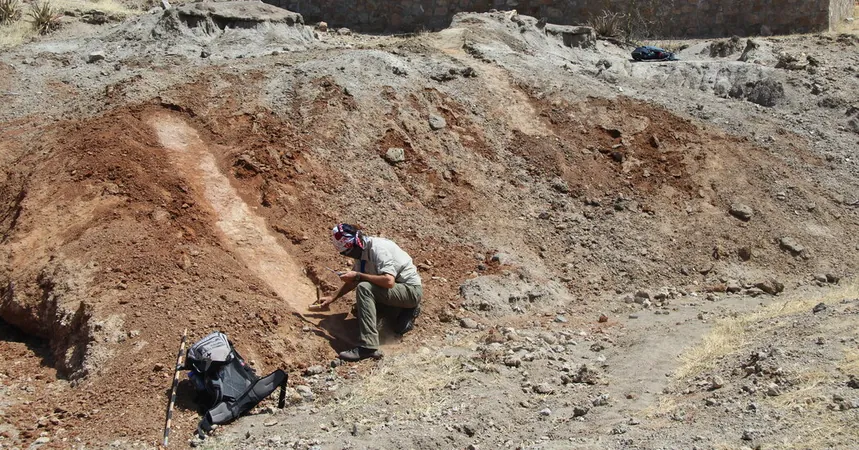
Shocking Discovery: Extinct Human Ancestors Thrived in Harsh Deserts!
2025-01-16
Author: Ying
In a world where chimpanzees roam the lush African rainforests and orangutans swing through the jungles of Indonesia, we often pride ourselves on the incredible adaptability of Homo sapiens. Yet, a revolutionary study unveils a stunning twist in our evolutionary narrative—our extinct relatives, the Homo erectus, not only survived but thrived in an unforgiving desert landscape!
Published in the prestigious journal Communications Earth and Environment, this groundbreaking research led by Julio Mercader, an archaeologist from the University of Calgary, reveals that Homo erectus flourished in regions once dismissed as inhospitable as early as a million years ago. "This shifts the narrative of adaptability beyond just modern humans," Mercader emphasizes, opening our eyes to the impressive resilience of our ancient relatives.
Traditionally, the adaptability of our ancestors was viewed through a narrow lens. Early hominins, who split from other apes in Africa roughly six million years ago, were thought to be bound to open woodlands, avoiding extreme environments entirely. However, this new study paints an entirely different picture.
The research team meticulously analyzed fossil remains at Engaji Nanyor in northern Tanzania—a site previously rich with Homo erectus fossils. These early humans, who first stood upright around two million years ago and spread to distant lands like Indonesia before vanishing about 100,000 years ago, possessed remarkable abilities. They were not only the first to achieve our modern stature but also demonstrated a significant increase in brain size compared to earlier hominins.
By scrutinizing pollen fossils and analyzing geological data, the researchers uncovered that Engaji Nanyor transitioned from a mild woodland habitat to a dry, desert-like environment around a million years ago. “We were led to a pivotal question: How did Homo erectus manage to survive and even thrive under such challenging conditions?” said Dr. Mercader.
Instead of fleeing to more hospitable zones, these ancient hominins showcased incredible adaptability. They altered their scavenging techniques, targeting resources like animal carcasses at seasonal watering holes that materialized after storms. Not only did they enjoy the benefits of hydration, but they also took advantage of hunting opportunities in these fleeting ecosystems.
Moreover, Homo erectus demonstrated an innovative understanding of tool-making. They refined their techniques for crafting sharper blades from stones, carefully selecting materials and carrying their preferred tools as they trekked across the arid landscape. Paul Durkin, a geologist involved in the study, remarked, “They seemed to have strategies for survival, planning ahead for when food sources became available.”
The research further reveals that the adaptability of Homo erectus at Engaji Nanyor may have served as a launching pad for their eventual migrations beyond Africa, permeating the Middle East and Asia.
In parallel, another research team led by Dr. Zeller is leveraging advanced climate models to examine ancient environmental conditions during human evolution. Their findings are in harmony with the new discoveries, suggesting that Homo erectus could have thrived in climates previously deemed unsuitable.
As these scientific narratives converge, Dr. Zeller asserts, “We must explore our evolutionary past more comprehensively to truly appreciate the scope of our adaptability.”
Get ready for more astonishing revelations as researchers delve deeper into the untold stories of our human ancestors! Could there be more surprises waiting to be uncovered in the sands of time? Stay tuned!


 Brasil (PT)
Brasil (PT)
 Canada (EN)
Canada (EN)
 Chile (ES)
Chile (ES)
 Česko (CS)
Česko (CS)
 대한민국 (KO)
대한민국 (KO)
 España (ES)
España (ES)
 France (FR)
France (FR)
 Hong Kong (EN)
Hong Kong (EN)
 Italia (IT)
Italia (IT)
 日本 (JA)
日本 (JA)
 Magyarország (HU)
Magyarország (HU)
 Norge (NO)
Norge (NO)
 Polska (PL)
Polska (PL)
 Schweiz (DE)
Schweiz (DE)
 Singapore (EN)
Singapore (EN)
 Sverige (SV)
Sverige (SV)
 Suomi (FI)
Suomi (FI)
 Türkiye (TR)
Türkiye (TR)
 الإمارات العربية المتحدة (AR)
الإمارات العربية المتحدة (AR)